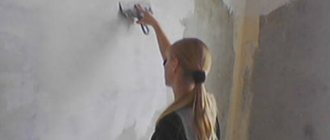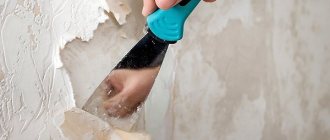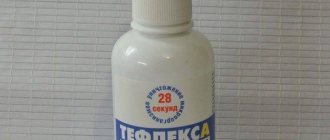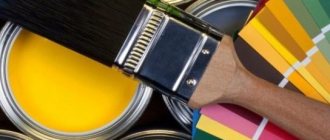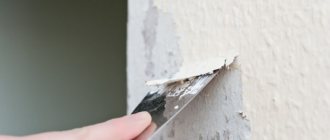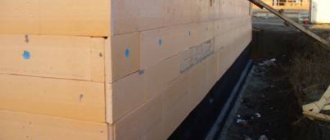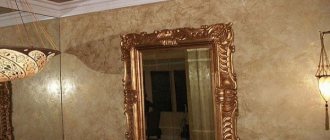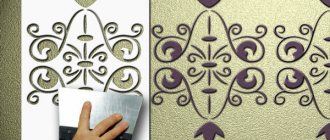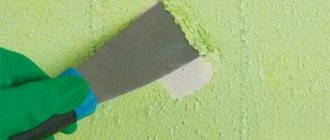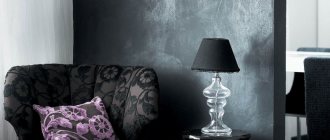Modern apartments are unlikely to boast walls covered with lime whitewash, but in old houses it is quite possible to encounter such a phenomenon. Before finishing such walls with other materials, it is necessary to completely remove the old design layer (it makes it impossible to glue wallpaper and paint the walls). There are several simple ways to achieve the best results in cleaning areas that were once whitewashed - in this article we will tell you how to remove whitewash from walls as efficiently as possible.
What you will need
Before starting the process, it is necessary to carefully prepare the room itself. All furniture and carpets are removed; items that cannot be removed should be covered with film to prevent dust particles from getting on them. Dust can also cover the floors in a thick layer, so save yourself the extra work of cleaning the floor and lay down a protective film in advance.
The work ahead is not only labor-intensive, but also poses considerable danger to an unprotected person. Protecting yourself is quite simple - prepare a protective set of clothing, consisting of a respirator, special overalls, goggles and rubber gloves. And finally, before telling you how to remove whitewash from walls, let’s outline the required equipment - without it, starting work is pointless.
For dry removal you will need the following tools: a grinding machine (a desirable device if you decide to clean the walls from whitewash using a dry method), in addition to it, use a spatula or scraper (the process will be delayed, but will be no less effective).
If you decide to wash off the lime, you will need: water, a large container for it, a sponge or foam rollers (they are much more convenient to use), a spatula and a rag.
Stripping solutions
In order to avoid the formation of dust when removing the layer covering the walls, special solutions are used. You can make them yourself or buy them in a store. As a result of their reaction with whitewash substances, the layer that needs to be removed softens and comes off without effort.
The determining factor when choosing a solution is what substance was used for whitewashing: lime or chalk.
Homemade
Homemade solutions are not only very easy to prepare, but it also saves money, since all the necessary components are not expensive and are always on hand.
To wash off lime
If the walls were treated with lime, you will need the following preparations:
- vinegar;
- shower gel or shampoo;
- warm temperature water.
Procedure:
- Pour 5-5.5 liters of water into a bucket.
- In a separate container, mix 1 small spoon of vinegar and half a glass of shower gel.
- Pour the gel and vinegar mixture into a bucket.
- Stir.
To remove chalk
In situations where the walls were whitewashed with chalk, the following components will be needed for the solution:
- soda;
- laundry soap.
Procedure:
- Grate the soap at the rate of 50 grams per serving of solution.
- In a separate container, mix the resulting soap shavings with 30 grams of soda.
- Fill a bucket with 5-6 liters of water.
- Add soda-soap mixture.
- Stir until dissolved.
Purchased
In addition to self-prepared washes, you can use purchased professional formulations. You can purchase them in construction stores or order them online, even with delivery.
Removers are designed for high-quality cleaning of whitewash from various surfaces, including for restoring order after repair work. When purchasing a product, you need to clarify which whitewash (lime or chalk) the solution will be active against.
Examples of effective washes:
- ALFA-20;
- Metylan;
- PROBEL;
- Quelyd Dissoucol.
The average price is from 600 rubles. for a volume of 5 liters.
If the thickness of the whitewash layer is large, then before applying special agents, the walls must be treated by cleaning, for example, by grinding with a machine or with a spatula.
Instructions
There are many technologies for removing whitewash, but let’s consider the two most effective: dry and wet removal. We will provide detailed step-by-step instructions for each of them, so that the repair work does not cause a lot of trouble for apartment owners.
Dry removal
This method will extremely quickly and effectively remove a layer of whitewash from the walls, so if there is little time allotted for repair work, you can use exactly this method. However, keep in mind that when the grinding machine works intensively, quite a large amount of dust is generated, which subsequently settles literally everywhere: on the floor, pieces of furniture, hair and clothes of workers. When choosing a dry option, protect yourself and the room from an abundance of dust.
If you have a grinding machine, it will be much easier to figure it out. The algorithm of actions is as follows:
- We take the device and choose the coarsest sandpaper for it - this way we will achieve the maximum effect.
- We plug the machine into the outlet.
- Slowly and very carefully walk through the areas where the whitewash is being removed - remove the largest elements of lime.
- Having removed the most significant pieces, complete the cleaning of the selected area by grinding (there is no need for feverish movements, calmness and smoothness are the key to success).
- After sanding is completed, carefully remove any dirt and dust found on the floor. You can simply get rid of them along with the film.
- Cleaning the room. It is recommended to wash the floors several times.
However, not everyone has a sanding machine. Although in the absence of this tool, it is possible to carry out dry cleaning.
Firstly, the simultaneous use of a hammer and spatula is allowed. First, a large piece is knocked down with a hammer, and the remainder is carefully pryed off with a spatula and removed.
Secondly, it is quite possible to do without a hammer, but in this case you will have to spend a lot more effort and time. This option involves removing the whitewash layer from the wall exclusively with a spatula. Naturally, large and small pieces will have to be broken off only by him, which is why the process is delayed for several hours.
Wet option
How to wash whitewash from walls? The wet removal method is quite old and proven. There are also options: use only water or use a special solution.
If there is enough water, the sequence is:
- Fill a basin with water.
- Wet and squeeze the sponge well so that it is saturated with moisture, but the water does not run down your hands.
- A foam roller will be incredibly convenient to use – it makes it much easier to clean walls.
- Moisten the desired area, completely saturating the lime with moisture.
- The procedure for washing off the whitewash will have to be repeated several times to achieve the ideal result.
- Remove the residue using a spatula. When the lime has softened, there should be no problems.
- The wall has been cleaned - now we tidy up the room and remove the garbage.
Saving time, they choose another method - washing off the whitewash with a solution. It is easy to find in a specialized store, but if you value not only time, but also money, you can really prepare such a mixture yourself. Let's look at some recipes.
The first is prepared from ammonia, soda and vinegar. To begin with, you will need 3 liters of water, to which the following components are added. Buy ordinary ammonia at the pharmacy, dilute it with water and take 2 tbsp. spoons. We do the same with soda - dissolve it in water in a ratio of 1:3 and pour it completely into our solution. You will also need a spoon of table vinegar and a few caps of bubble bath. We complete the preparations: heat the resulting mixture to 50 degrees and pour in 2 liters of water.
The second option is to make a solution of 2% hydrochloric acid and copper sulfate. It will very quickly remove the old layer of whitewash, but in itself it is poisonous, do not forget protective clothing. Just apply it to the wall with a roller, wait 20 minutes and feel free to remove the residue with a spatula.
Removing whitewash using pastes
Removing whitewash using pastes allows the whitewash to come off more easily.
The newest way to remove old whitewash from the ceiling is to use pastes. Many people use this today, since the use of adhesives leaves a small amount of dirt from the whitewash and causes it to lag well from the ceiling surface.
- Take and dilute regular wallpaper glue. Let it sit for a while, then use a roller or large paint brush to apply a thick, even layer to the ceiling surface. After the liquid has completely dried, you can take a thin scraper and remove the whitewash. Since it will be removed along with the glue, you can avoid a lot of chalk dust.
- You can also use your own prepared paste. To do this, heat the water and add starch to it. Instead of starch, you can use flour. It is advisable to heat the water well so that it is hot enough. Mix the whole mixture well, and then immediately apply it to the ceiling with a brush. Then wait until it dries and remove all the whitewash. It is recommended to do this using a very stiff, short-bristled brush. Using a metal brush also gives a good effect. Residues can be cleaned with a hard sponge.
How to remove paint from walls
In order for the cleaning of painted walls to be effective, you need to know two things:
- What is the base of the surface you are going to work with: brick, concrete, cement or plastered.
- What paint are the walls painted with: oil, water-based or acrylic.
USEFUL INFORMATION: Kitchen renovation: where to start, main stages
The most difficult part is removing oil paint from a concrete surface. But you can cope with such a difficult task if you have all the necessary tools and means at hand. Can be used:
- grinder with nozzle;
- spatulas, chisels, scrapers;
- hammer drill or electric drill with an attachment;
- paint thinners;
- axe;
- construction hairdryer
There are three ways to remove old paint from walls, each of which has its own pros and cons.
Mechanical
The mechanical method is the dustiest, but the least toxic compared to the next two. You can remove the paint manually: beat off individual areas of the surface with an ax or hammer with a chisel. If you choose the right angle of the ax, the paint will be easy to remove.
When working with an angle grinder there will be a lot of dust, so it is better to use a hammer drill or a drill with a chain attachment. The tool uses chain links to knock off the paint, which flies off in pieces and does not collect dust.
Chemical
This method is less labor intensive. It is necessary to apply a special reagent to the surface, under the influence of which the paint softens and is removed with a scraper.
Thermal
This method is simple, but toxic, like a chemical one. The essence of it is to heat the surface with a construction hairdryer until the paint begins to bubble, and remove it with a scraper.
Important points:
- To make it easier to remove water-based paint from concrete, you need to moisten the surface with an iodine solution (10 ml of iodine per 1 liter of water).
- You need to remove acrylic paint by first spraying the wall with water mixed with alcohol or acetone.
- Oil, water-based and acrylic paints can be successfully removed using all three methods.
Features of cleaning the ceiling from whitewashing with water
The process is long and labor-intensive, but effective and budget-friendly. This method is most often used to remove chalk whitewash because it is less aggressive and moisture resistant. To work, we need a regular soft foam sponge and table salt. During the process we follow these instructions:
- Dissolve 1 kg of salt in 10 liters of hot water.
- Cool the composition to +45 degrees.
- Using a sponge, apply it to the ceiling using rotational movements.
The solution must be replaced as often as possible, washing off the layer with a sponge until the previous surface coating is visible. Then the surface should be treated with coarse sanding paper.
How to remove whitewash: materials and tools
- Safety glasses and respirator. The work is very dusty and dangerous for the eyes, so you need to take care of yourself first
- A special scraper or a well-sharpened metal spatula 6-8cm wide
- Wire brush
- A metal or plastic basin for water to wash away the lime.
In different cases, whitewashing with lime lasts differently, so the methods for removing it may differ slightly: sometimes you can get away with simply washing it off, and sometimes you have to scrape off the old whitewash centimeter by centimeter with a spatula.
Technology
Let's consider the stages of traditional washing of whitewash from the ceiling.
- You have water and a spray bottle. Now you need to moisten the ceiling. Try to do this evenly. If you pour a lot of water in the same place, it will eventually start dripping from the ceiling. The whitewash should absorb moisture. Only in this case will the chalk swell. Therefore, take a small area of a couple of square meters and begin to moisten them evenly. If you notice that the water has been absorbed, wait 10 minutes and then moisten the same area again.
- Now you can eliminate the old whitewash. At this stage, a spatula will come in handy, with which you will have to clean off the whitewash. If you have properly moistened the ceiling, the chalk will come off in thin layers. If the whitewash runs down the trowel, you have used too much water.
- To ensure that the work occurs continuously, while one part of the ceiling absorbs water before the second pass, moisten the remaining areas. While you are cleaning the chalk from one place, another will already be completely saturated with water.
- At the end of the work, the ceiling must be washed. Warm water and a foam sponge will help with this. It’s easy to check the quality of work: when the ceiling is dry from water, run your finger over it. If there are no white marks on your finger, then you did everything right. If there is some chalk left on the surface, there is no need to start washing again. It is enough to apply a primer for whitewashed surfaces to the ceiling.
